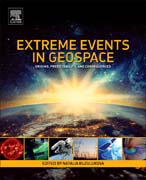
Extreme Events in Geospace: Origins, Predictability, and Consequences
Buzulukova, Natalia
Extreme Events in Geospace: Origins, Predictability, and Consequences explores the complex, inter-related phenomena of extreme space weather events. Written by representatives from many different fields of space research, the book discusses definitions, historical knowledge, operational issues and modeling. Extremes in radiation ionization, radiation belts and ionospheric irregularities can disrupt technologies and pose danger to human health, so it is important to synthesize information about the consequences, origins and predictability of such events. An important source of current research for geophysicists, space weather scientists and industries impacted by space weather events, the book covers telecommunications, satellite communications and space flight. Helps define extreme eventsDescribes existing modeling capabilities of extreme eventsProvides an overview of current operational capabilities and challenges Offers improved understanding of the ways in which space weather may affect daily life Demonstrates deep connections between astrophysics, heliophysics and space weather applications, including a discussion of extreme space weather events from the past, when our Sun was young and more active than it is now Includes discussions of definition, operational issues, connections between operational issues and science, modeling/prediction and historical aspects INDICE: Introduction: Linking Space Weather Science to Impacts - The View from Earth 1. Extreme Solar Eruptions and their Space Weather Consequences 2. Super Magnetic Storms: Past, Present, and Future 3. Solar Flare Forecasting: Present Methods and Challenges 4. How the Thermosphere and Ionosphere Might React to an Extreme Space Weather Event 5. Understanding Extreme Geomagnetically Induced Currents 6. Extreme Ionospheric Storms and Their Effects on GPS Systems 7. Recent Geoeffective Space Weather Events and Technological System Impacts 8. Extreme Events in Atmospheric Radiation at Aviation and Suborbital Altitudes 9. Solar Particle Events and Human Deep Space Exploration: Measurements and Considerations 10. Extreme-Event Geoelectric Hazard Maps 11. Prediction of Magnetospheric Relativistic Electron Dropouts (REDs) and Acceleration 12. Global 3D Modeling of the Earth's Magnetosphere for Extreme Geomagnetic Storms 13. Data-Driven Modeling of Extreme Space Weather Events and their Predictability 14. Observations of Historical Extreme Events from GOES and POES s/c 15. NASA Perspective on Research of Extreme Space Weather Events 16. Space Weather: What Are Policy Makers Seeking? 17. Extreme Space Weather Research in Japan 18. Dealing with Extreme Space Weather: The Canadian Experience 19. Extreme Space Weather Events in the Australian Context 20. Solar Proton Events and Ozonosphere of the Earth (Observations and Model Simulations) 21. Ionosphere and Thermosphere Responses to Extreme Geomagnetic Storms 22. Observations of Thermospheric Response to Extreme Events 23. Extreme Space Weather in Time: Effects on Earth and Mars 24. Extreme Space Weather and Emergency Management 25. The Statistics of Extreme Space Weather Events 26. Empirical Geomagnetic Field Modeling of Extreme Events: Storm-time Pressure Distributions and Validation Using Van Allen Probes Data 27. High Energy Transient Luminous Atmospheric Phenomena: The Potential Danger for Suborbital Flights? 28. Near-Earth Radiation Environment for Extreme Solar and Geomagnetic Conditions 29. Geo-effectiveness of Solar and Interplanetary Structures and Generation of Strong Geomagnetic Storms 30. The Effect of Solar Radio Burst on GNSS System 31. Extreme Space Weather Spacecraft Charging and Arcing Effects 32. Deep Dielectric Charging and Spacecraft Anomalies
- ISBN: 978-0-12-812700-1
- Editorial: Elsevier
- Encuadernacion: Rústica
- Páginas: 625
- Fecha Publicación: 01/01/2018
- Nº Volúmenes: 1
- Idioma: Inglés
